Basal Cell Carcinoma
Basal cell carcinoma is the most common form of skin cancer with more than one million occurring in the United States annually. They are the result of significant sun exposure. More than 90% occur on predominantly sun exposed areas. Basal cell carcinomas rarely metastasize or spread, but they do not go away on their own. They are locally destructive to surrounding tissue and can cause loss of an ear, nose, etc., if left untreated.
Basal cell carcinomas are usually slow growing. They may present as a small pimple-like growth with a fine, pearly border, as a shiny persistently pink area, a scar, a depression, or as a sore that will not heal. They may or may not be pigmented.
Basal cell carcinomas have a high cure rate. The type of basal cell carcinoma, the size, and location are all used to determine the most appropriate treatment. Biopsy of a suspected lesion will help decide the best method of treatment. Treatment could include electrodessication and curettage (removal by scraping and cauterizing with an electric needle), which is the most tissue sparing, surgical excision, cryosurgery (freezing with liquid nitrogen), topical anti-cancer agents, Mohs micrographic surgery, or radiation therapy.
Studies show that a person who develops one basal cell carcinoma has a 43% risk of getting a second basal cell carcinoma within five years. It is important to have a full body skin examination at least once a year and to do regular self-exams. Be alert to any non-healing sores or lesions that are growing, changing, or bleeding. Since basal cell carcinoma is most frequently caused by the sun’s rays, proper sun protection is important (see section on sunscreens).
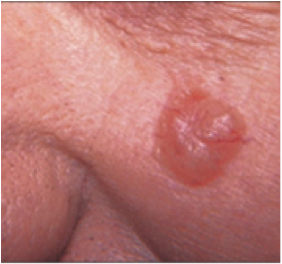
Nodular Basal Cell Carcinoma
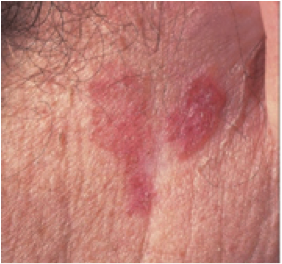
Superficial Basal Cell Carcinoma
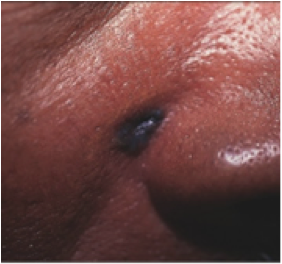
Pigmented Nodular Basal
Cell Carcinoma
Squamous Cell Carcinoma
Squamous cell carcinoma is the second most common type of skin cancer. People with fair complexions and a lot of sun exposure are most commonly affected. Squamous cell carcinoma, while not as serious as malignant melanoma, can metastasize or spread to other parts of the body. It is also locally destructive, so early detection and treatment is important. Squamous cell carcinomas can appear as scaly or crusted flat areas or bumps on the skin often with a red inflamed base, a growing tumor, or a non-healing ulcer. A skin biopsy can confirm the diagnosis. Treatment of choice is dependent upon the location of the tumor, its size, and its microscopic characteristics, and could include surgical excision, electrodessication and curettage (removal by scraping and cauterizing with an electric needle), cryosurgery (freezing with liquid nitrogen), anti-cancer agents, Mohs micrographic surgery and/or radiation therapy.
Squamous cell carcinomas can occur in old burns and chronically traumatized skin. They also are more common in long-standing, immunosuppressed patients (i.e. those who have had transplants).
Sun protection is the best defense against skin cancer caused by UV radiation. Wearing a broad spectrum sunscreen that protects against both UVB and UVA rays is important. Regular self-examinations and being on the alert for any growing, changing, bleeding or non-healing lesions is important. Annual full body skin examinations are recommended especially in patients who have history of skin cancers.
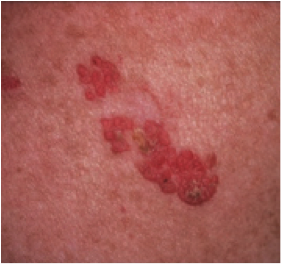
Squamous Cell Carcinoma in Situ (Bowen's Disease)
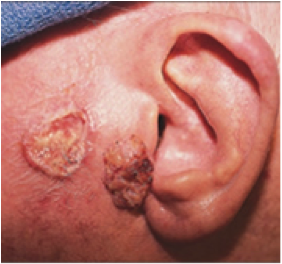
Squamous Cell Carcinoma
Next »




